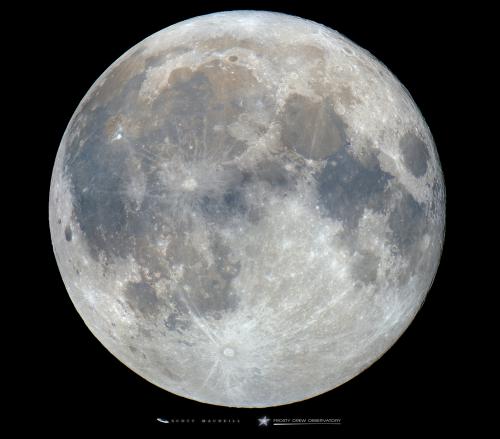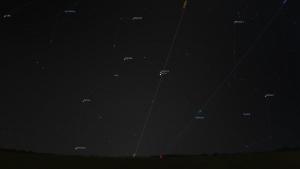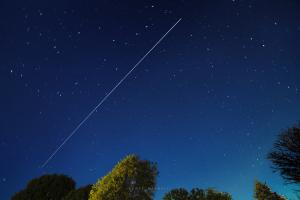Celebration of Space - October 2, 2020
Last night, Thursday, October 1, 2020, the NG CRS-14 (ISS resupply) launch from Whallops Flight Facility in Virginia was scrubbed. The next launch window opens at 9:16 pm ET tonight (October 2, 2020). The launch will carry 8,000 lbs of research, crew supplies, and hardware to the International Space Station. Though the launch will follow a Southeast heading, we may catch a low horizon view of the launch vehicle racing out of Earth’s atmosphere about 3 minutes after launch. Weather forecasts look amazing for viewing the launch from our region. The best way to attempt a view is to head out for 9:00 pm to a location with a very low view of the SSE horizon. Also, the further south you can be, the better! My choice would be Point Judith, Beavertail, or Brenton Point. If the launch goes according to schedule, the launch vehicle should become visible around 9:19 - 9:20 pm, very low on the SSE horizon, like a star moving quickly on an easterly track. If you catch a view, let us know!
Early tomorrow morning, Saturday, October 3, 2020, at around 4:30 am, step outside and look to the east. Venus and the bright star Regulus will be putting on quite a show with Venus sitting about 0.4° below the bright blue star. Regulus is the brightest star in the constellation Leo, and one of the brightest stars on the ecliptic, which is the path the Sun takes across the sky and represents the plane of the Solar System. Being on or near the ecliptic, makes this a fabulous candidate star for conjunctions and occultations regarding Solar System bodies. Considering that Regulus is actually very blue, and we miss out on this due to its brightness on the black(ish) background of space, when Regulus comes close to planets during a conjunction, depending on the planet, the color contrast will really bring into view the deep blue of Regulus. Will this happen with Venus? Step outside tomorrow morning and see for yourself. Regardless, it will certainly be worth the early Saturday morning excursion into your backyard. To view, step outside after 4:30 am, but no later than 5:30 am, and look to the east. Venus will be the brightest object in the sky (aside from the Moon), and Regulus will be just above it. If you catch a photo, post it on our Facebook and we’ll share it to our timeline.
Did anybody catch a view of last night’s Full Moon? Well that was the Full Hunter’s Moon of October. Though in 2020 it also took on the moniker of the Harvest Moon. Most sky watchers associate the September Full Moon with the Harvest Moon, though the full September Moon is called the Full Corn Moon. The Harvest Moon is defined as the closest Full Moon to occur near the Autumnal Equinox. Which is usually the September Full Moon. But in 2020, October has two occurrences of the Full Moon. This placed last night’s Full Moon closest to the Autumnal Equinox, which occurred on September 22, 2020. The second Full Moon of October will happen on Halloween. By modern definition, it will be considered at Blue Moon. But for the purists that stick to the original definition, which states that the third Full Moon in a season of four Full Moons is the Blue Moon, it will not be a Blue Moon. Regardless, having a Full Moon on Halloween will be a nice addition to the night, and will bring a little extra light for those out celebrating the eve of all hallows.
Over the past week and half, we have had numerous passes of the International Space Station over the US during the evening hours. Well amazing evening passes continue this week, with a step up in the quality of passes. Here are notable passes for this weekend and coming week:
Fri, Oct 2 at 6:56 pm, starting in NNW, rising to 20°, heading towards ENE
Sat, Oct 3 at 7:46 pm, starting in NW, rising to 50°, and into orbital sunset ← Awesome Pass!
Sun, Oct 4 at 6:58 pm, starting in NW, rising to 34°, heading towards NNE
Mon, Oct 5 at 7:48 pm, starting in WNW, rising to 58°, and into orbital sunset ← Awesome Pass!
Tue, Oct 6 at 7:01 pm, starting in NW, rising to 83°, heading towards NE ← Awesome Pass!
Wed, Oct 7 at 7:51 pm, starting in W, rising to 19°, heading towards SW
Thu, Oct 8 at 7:03 pm, staring in WNW, rising to 32°, heading towards SSE
Put these times on your calendar or set your alarm. There are several awesome passes happening this week that you will not want to miss. Note that these times are applicable for Southern New England, and generally acceptable for the Northeast. For pass times specific to your location, visit NASAs Spot the Station. Now get out and catch a view of humanity’s only continuously inhabited space based residence zoom by, and remind yourself of the amazing things we do in the face of danger!
- Author:
- Scott MacNeill
- Entry Date:
- Oct 2, 2020
- Published Under:
- Scott MacNeill's Columns





